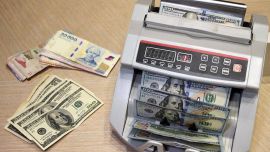Mired in a seemingly never-ending series of economic crises, Argentina has, grudgingly, been exporting its top football players for decades. As passionate as the local fan base may be, the teams here simply never had enough financial might to compete with the contracts dangled by top foreign clubs.
So when River Plate, a perennial power in the local league, threw down US$10 million to lure star midfielder Sebastián Driussi back home in January, it raised eyebrows. The million-dollar signings kept coming and piled up quickly, one after the other: Gonzalo Montiel, the 2022 World Cup hero, joined Driussi at River in Buenos Aires; Alan Velasco signed with crosstown rivals Boca Juniors; and Facundo Farías landed at Estudiantes in nearby La Plata. Even some foreign-born stars — from Spain, Brazil, Colombia and Costa Rica — cut big deals.
Suddenly, there are more than two dozen players making US$1 million or more a year in Argentina, according to media outlets that track the deals. A couple of years ago, there were only a handful — maybe 10 at the most, they estimate.
This is the Javier Milei effect. Fifteen months into office, the libertarian leader’s all-out push to slash the government’s budget deficit has brought newfound stability to the peso. So much so that, after factoring in the country’s double-digit inflation rate, the currency is actually strengthening sharply against the dollar.
By this measure, the Central Bank estimates the peso is now the strongest it’s been in almost a decade. That’s giving jubilant Argentines the purchasing power to go on weekend shopping sprees over the border in Chile, sip caipirinhas on the beach in Rio de Janeiro and, when it comes to the game they love, snap up the contracts of strikers and goalies overseas.
This new financial might earns Milei so much good will among poor and rich Argentines alike — his poll numbers remain resilient after more than a year of tough austerity — that pundits predict he’ll emerge largely unscathed from the embarrassing crypto scandal he was ensnared into this month.
Diego Lemme, president of Defensa y Justicia, a small soccer club on the outskirts of Buenos Aires, said local salaries had gotten so low in dollar terms before Milei took office that even teams in obscure markets like Paraguay and Bolivia were luring away Argentine players. Last month, Lemme signed two players who were under contract abroad. “The stronger peso made us more competitive,” he said.
To many investors and analysts, the renaissance of Argentine football is emblematic of the mounting risks to Milei’s plan to fix the nation’s finances, crush inflation and spark an economic boom. While he has been successful in rapidly bringing down inflation, the 23 percent yearly rate forecast for 2025 in the latest Central Bank survey is still far higher than the global average. And the longer Milei keeps a lid on the peso, allowing it to slip only a tiny amount against the dollar each day, the more cars, dishwashers and football players the country will import.
The resulting deterioration in the country’s trade accounts, analysts warn, could ultimately spark the kind of large-scale peso collapse that has rocked the economy so many times before. “The overvalued peso is a reality,” says Aldo Abram, executive director at Fundación Libertad y Progreso, a think tank that focuses on public policy.
Milei and his economic aides have little time for such arguments. To them, a stable peso, even if propped up to a certain degree, is crucial to their campaign to eradicate inflation. Moreover, they say they have plenty of dollar inflows to sustain it. So any time a well-known figure in Argentine financial circles expresses concerns about the peso, they lash out.
Two weeks ago, Milei fired Sonia Cavallo, Argentina’s ambassador to the Organisation of American States, after her father, the former economy minister Domingo Cavallo, fretted about the peso’s “exaggerated appreciation” in a blog post. “You’re either on one side or the other,” Milei said in a radio interview, confirming her dismissal.
There are, of course, still limits on the purchasing power of football clubs here. The very top Argentine players — like Lionel Messi or Julián Álvarez — remain far out of their financial reach. And Boca Juniors couldn’t even cobble together enough money to land Leandro Paredes, a squad player on the 2022 World Cup championship team who plays with AS Roma in Italy’s top league. Talks between the two sides have broken down and Paredes will remain in Europe.
Officials from River Plate and Boca Juniors declined to comment for this story, and Argentina’s main players union didn’t respond to a request about salaries.
Football teams are prohibited from paying players in dollars. So they pay them the equivalent of a dollar amount in pesos over the life of what is typically a two-year contract. For teams, the risk is that the currency suddenly plunges, as some analysts fear, and forces them to shell out more and more pesos to honour those contracts.
Argentina’s peso currently trades at about 1,060 per dollar using the official exchange rate, which Milei’s government tightly controls. It was worth about 365 per dollar when the president took office in December 2023. He immediately slashed its value by more than half before instituting a gradual depreciation policy known as a “crawling peg.” So Driussi’s contract, which was worth about 10.4 billion pesos when it was agreed in mid-January, is now worth 10.6 billion pesos.
“You always have to be aware of currency risk,” says Hernán Lacunza, the vice-president of Racing Club, one of the country’s top teams. Lacunza, an economist who once served as the country’s economy minister, was surprised when he took the job at Racing at the end of last year to learn that most local football teams didn’t properly analyse their ability to withstand declines in the peso. He immediately began running those calculations at Racing, which brought in three players from abroad last year and another since he joined.
“What seems affordable in dollars today might not be tomorrow,” Lacunza said. “You have to have an idea of what the team’s breakeven exchange rate is.”
by Ignacio Olivera Doll, Bloomberg






















Comments